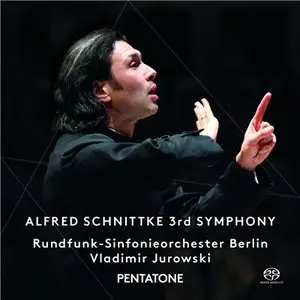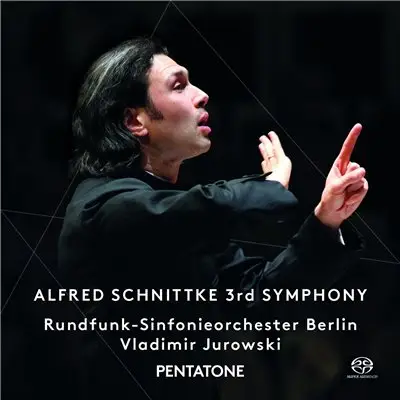Jurowski, Berlin Radio Symphony Orchestra - Schnittke: 3rd Symphony (2015)
EAC Rip | Flac (Image + cue + log) | 1 CD | Full Scans | 225 MB
Genre: Classical | Label: Pentatone | Catalog Number: 186485
EAC Rip | Flac (Image + cue + log) | 1 CD | Full Scans | 225 MB
Genre: Classical | Label: Pentatone | Catalog Number: 186485
One hundred and eleven musicians celebrating a large-scale symphony that sounds like Gustav Mahler, Richard Strauss, or Arnold Schoenberg. In fact, the composer of this symphony, Alfred Schnittke, had precisely these composers (and many others) in mind back in 1981. Whereas he initially mirrored certain styles from figures as Mahler, Mozart, Bach, Stravinsky, Prokofiev and Shostakovich, he was soon also borrowing concepts from trivial music, folklore, jazz, tango, as well as many other styles. He himself described his compositional technique, but an aesthetic programme: a serious effort to break through the vicious circle of the self-satisfied and self-sufficient avant-garde music.
Alfred Schnittkes 3rd Symphony testifies all this searching, this in-betweenness. The four-movement work an opening Moderato, followed by an Allegro, a long movement marked Allegro pesante, with the briefer finale marked Adagio was commissioned for the ceremonial opening of the new Gewandhaus in Leipzig. He used the prestigious commission from Leipzig as a moment to confront not only the multi-layered historical past, but also the weakened current state of affairs while remaining highly respectful of the achievements of both the past and the present.
Released on SACD by Pentatone, this symphony is recorded with Vladimir Jurowski conducting the Rundfunk-Sinfonieorchester Berlin. Jurowski states, He (Schnittke) was not alone in his capacity of seismograph of the cultural nightmares of his/our present. The conductors insightful, unique reading and his collaboration with an orchestra who are on top form undeniably produced nothing less that a magnificent tribute to Schnittkes great and intricate score.
Composer: Alfred Schnittke
Conductor: Vladimir Jurowski
Orchestra/Ensemble: Berlin Radio Symphony Orchestra
Reviews: This new recording of Schnittke's Symphony No. 3 was made in the studio and is conducted by the Berlin-based and Moscow-born Vladimir Jurowski. There are few orchestras that play twentieth-century music as well as the Rundfunk-Sinfonieorchester Berlin. They have performed in a number of excellent recordings including the acclaimed set of the complete Hans Werner Henze symphonies and other orchestral works on Wergo.
It is difficult to claim a single compositional voice from Alfred Schnittke as the multi-faceted nature of his music ranges from Arvo Pärt-like spirituality to twelve-tone or ‘serial’ to neo-classical and to what he described as ‘polystylism’ an eclectic approach of varying often contradictory styles. Born to a Jewish father and German Roman Catholic mother, but raised in the Soviet Union, Schnittke was one of the foremost composers of the post-Shostakovich generation. He lived under the strictures of Soviet cultural policy and suffered from disapproval by the authorities for being too Western-European influenced. The increasing opportunities that Glasnost presented in the USSR assisted Schnittke’s emergence as a composer of international note. He became highly fashionable for a time, although, it is rare to see his music programmed today. A prolific composer, he has been especially effective in the field of unaccompanied sacred choral with his Konzert für Chor (Concerto for Choir) considered by many to be a choral masterpiece.
Schnittke wrote eight symphonies leaving a ninth unfinished together with an early symphony No. ‘0’ which he didn’t acknowledge. They have all been reocrded by Bis in their Schnittke Edition (BIS-CD-1767/68). By the time of writing the complex Symphony No. 3 in 1981 Schnittke had some years earlier lost his rather short-lived fascination for the Western avant-garde and was following a ‘polystylism’ approach of composition. The Symphony No. 3 a commission for the inauguration of the new Gewandhaus was premièred the same year by the Leipzig Gewandhausorchester under Kurt Masur. Owing to this provenance the work is sometimes referred to as the ‘Leipzig’ Symphony. In the Soviet Union the first performance was given in 1982 by the USSR Ministry of Culture Symphony Orchestra under Gennadi Rozhdestvensky who recorded it in 1984 for Melodiya (SUCD 10 00064). It’s a massive work cast in four movements and orchestrated in the manner of Richard Strauss and Mahler requiring one hundred and eleven orchestral players.
It is not always easy to make sense of its construction. Schnittke incorporates paraphrases from Austro/German music and uses quasi-quotes rather than literal quotes from a line-up of twenty-eight Austro/German composers from initials of their names ‘monograms’ and also a small number of words emblematic to the commission such as ‘Leipzig’ and ‘Thomaskirche’ all woven into the writing. These quasi-quotes lie hidden and I certainly couldn’t detect any particular themes from any composer except in the opening of the first movement which evokes the drone of the Prelude from Wagner’s Das Rheingold and Mozart’s Piano Sonata in C major, K545.
There's a formidable visceral energy about the writing and this coupled with intense engagement from Jurowski’s Berlin players creates a wide range of sonorities performed brilliantly and with real élan. The concentration given to the opening movement Moderato is remarkable. That Rheingold theme puts in an appearance and the dynamics swell gradually in menace from an almost inaudible pianissimo to a tremendous climax that recurs three times. Marked Allegro the opening of the second movement is vibrant and fresh - almost playful, dance-like, delicate and certainly charming. Several mood-changes occur suddenly and as the drama increases the writing becomes darker and more serious in tone. Especially memorable are the sinister feel to the harpsichord part, a haunted Straussian waltz and the electric guitar breaks. There is also what sounds like a quotation from the Prelude and Fugue No. 1 from J.S. Bach’s Well-Tempered Clavier - Book 1 (9.50-10.01) and in the Coda a direct quotation from Mozart’s Piano Sonata in C, K545. This eventually fades away on a cheerless note to nothing. Movement three, an Allegro pesante which extensively employs varied use of the monogram ‘das Böse’(The Evil), opens with ominously dark, weighty indeed fearsome music. This could easily represent the heavy tread of the Giants and the Dragon leitmotifs in Das Rheingold. The electric guitar wails and screams away repetitively and as the orchestral weight swells at point 6.53, clangorous, menacing and martially percussive, the loudness becomes almost unbearable. At nineteen minutes the lengthy Finale - Adagio contains a series of variations based on all twenty-eight composer monograms transformed into twelve-note rows and several themes. The prevailing mood is that of an uneasy calm with a curious sense of exhaustion evoking a bleak inhospitable wasteland, an aural picture I find so characteristic of Shostakovich. In a central passage the atmosphere is broken gradually as the weight and intensity increases for a fire-breathing outburst at 11.55-12.43. The uneasy and rather austere quietness returns and gradually decays to a silence in a way reminiscent of the haunting, rather otherworldly temperament of Strauss’s Death and Transfiguration.
Recorded at the Großer Sendesaal, Haus des Rundfunks of RBB with the Seifert organ at St. Matthias-Kirche, Schöneberg added later the sound quality of this SACD played on my standard player is out of the top drawer. A minor grumble is that fifty-two minutes is rather short measure and it’s hard to fathom why an additional work wasn’t placed on the release. Nevertheless the fascination of Schnittke’s Symphony No. 3 and the quality of this sublime performance from the Rundfunk-Sinfonieorchester Berlin under Vladimir Jurowski combine for a compelling aural experience. A release to entice the reasonably adventurous, this will undoubtedly be one of my 2015 Records of the Year.
Tracklisting:
[01] I. Moderato
[02] II. Allegro
[03] III. Allegro pesante
[04] IV. Adagio
Exact Audio Copy V1.0 beta 4 from 7. December 2014
EAC extraction logfile from 6. March 2015, 18:19
Rundfunk-Sinfonieorchester Berlin - Vladimir Jurowski / Schnittke - Symphonie Nr.3
Used drive : HL-DT-STDVD+-RW GU90N Adapter: 1 ID: 0
Read mode : Secure
Utilize accurate stream : Yes
Defeat audio cache : Yes
Make use of C2 pointers : No
Read offset correction : 102
Overread into Lead-In and Lead-Out : No
Fill up missing offset samples with silence : Yes
Delete leading and trailing silent blocks : No
Null samples used in CRC calculations : Yes
Used interface : Native Win32 interface for Win NT & 2000
Used output format : User Defined Encoder
Selected bitrate : 1024 kBit/s
Quality : High
Add ID3 tag : No
Command line compressor : C:\Program Files (x86)\FLAC\flac.exe
Additional command line options : -T "COMMENT=rip by el coronel" -8 -V %source%
TOC of the extracted CD
Track | Start | Length | Start sector | End sector
––––––––––––––––––––––––––––-
1 | 0:00.00 | 11:21.03 | 0 | 51077
2 | 11:21.03 | 13:22.48 | 51078 | 111275
3 | 24:43.51 | 8:15.36 | 111276 | 148436
4 | 32:59.12 | 19:08.44 | 148437 | 234580
Range status and errors
Selected range
Filename F:\Music\Schnittke 3 Jurowski\CD.wav
Peak level 96.1 %
Extraction speed 4.3 X
Range quality 100.0 %
Test CRC 79FEDCF9
Copy CRC 79FEDCF9
Copy OK
No errors occurred
AccurateRip summary
Track 1 not present in database
Track 2 not present in database
Track 3 not present in database
Track 4 not present in database
None of the tracks are present in the AccurateRip database
End of status report
–– CUETools DB Plugin V2.1.4
[CTDB TOCID: .rLA8eKgO3lVOzl.EWdJckyuPRs-] disk not present in database
Submit result: .rLA8eKgO3lVOzl.EWdJckyuPRs- has been uploaded
==== Log checksum E947E31006763E1ADE4BD949CF06BB5D05BE710B2446A5859C0D7A08E0BA293E ====
EAC extraction logfile from 6. March 2015, 18:19
Rundfunk-Sinfonieorchester Berlin - Vladimir Jurowski / Schnittke - Symphonie Nr.3
Used drive : HL-DT-STDVD+-RW GU90N Adapter: 1 ID: 0
Read mode : Secure
Utilize accurate stream : Yes
Defeat audio cache : Yes
Make use of C2 pointers : No
Read offset correction : 102
Overread into Lead-In and Lead-Out : No
Fill up missing offset samples with silence : Yes
Delete leading and trailing silent blocks : No
Null samples used in CRC calculations : Yes
Used interface : Native Win32 interface for Win NT & 2000
Used output format : User Defined Encoder
Selected bitrate : 1024 kBit/s
Quality : High
Add ID3 tag : No
Command line compressor : C:\Program Files (x86)\FLAC\flac.exe
Additional command line options : -T "COMMENT=rip by el coronel" -8 -V %source%
TOC of the extracted CD
Track | Start | Length | Start sector | End sector
––––––––––––––––––––––––––––-
1 | 0:00.00 | 11:21.03 | 0 | 51077
2 | 11:21.03 | 13:22.48 | 51078 | 111275
3 | 24:43.51 | 8:15.36 | 111276 | 148436
4 | 32:59.12 | 19:08.44 | 148437 | 234580
Range status and errors
Selected range
Filename F:\Music\Schnittke 3 Jurowski\CD.wav
Peak level 96.1 %
Extraction speed 4.3 X
Range quality 100.0 %
Test CRC 79FEDCF9
Copy CRC 79FEDCF9
Copy OK
No errors occurred
AccurateRip summary
Track 1 not present in database
Track 2 not present in database
Track 3 not present in database
Track 4 not present in database
None of the tracks are present in the AccurateRip database
End of status report
–– CUETools DB Plugin V2.1.4
[CTDB TOCID: .rLA8eKgO3lVOzl.EWdJckyuPRs-] disk not present in database
Submit result: .rLA8eKgO3lVOzl.EWdJckyuPRs- has been uploaded
==== Log checksum E947E31006763E1ADE4BD949CF06BB5D05BE710B2446A5859C0D7A08E0BA293E ====
Thanks to the original releaser



